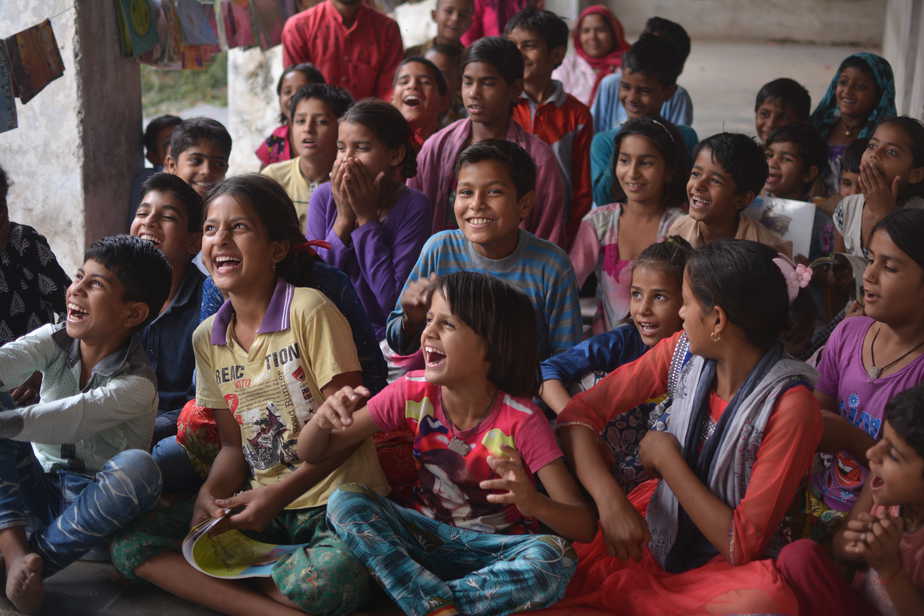
It takes a certain thoughtfulness to not miss the resemblance of a scalloped leaf with an imaginative form of human heart and also name it Lokesh. If you read the full story, accompanied with doodles by Neeru, a seven-year-old from Patan, a village of 400 families in Rajasthan, you will learn about her sensibilities. A story like “Dukhi Ped” written by the children of a nearby village, Rampura, got us thinking when we learnt about the misery of a thirsty tree which was nourished by schoolgoing children. We were told later that it was a true story. A thirsty tree in the midst of scorching Rajasthan.
An inventive mind like that does not come with six hours of schooling every day or even reading the most celebrated literature. Sometimes, it is the unavailability of a standard that adds to one’s experience and understanding of things, as seen in the drawings made by the young kids living in villages as part of the library programme of NGO Organisation of Early Literacy Promotion (OELP) in seven villages of Rajasthan.
Walking into any one of these community spaces that are appointed by the local government to be used as libraries is one’s opportunity to see something they haven’t before. While one spends the next few minutes gazing at the interiors of the library, they will see, even with no artificial lighting, the room lit with a perfect blend of sunlight, vivid drawings and Hindi alphabet, loosely scribbled on colourful chart paper pasted onto the walls. Story books by various publishers like Pratham, Tulika, Eklavya, Katha, Takshashila and many others are carefully laid inside multiple pouches hung around the room, colour-coded to suit various age groups.
A regular day at these libraries has kids learning to read and write Hindi, read aloud stories from these books to creating their own picture stories on loose sheets of paper. One of the recent activities has been to come up with their own newspaper, where kids document the important goings-on of the village. A newspaper that looks very close to one’s diary, with events noted in emotive words and drawings, gives us a view of a child’s empathy towards life around him/her. Some kids will also show you their house on the village map sketched on the wall, while others will want to sing aloud the slogan that pays a tribute to their village.
The youngest lot that comes with their elder siblings make the most beautiful drawings and read stories from books with such delight that you would miss the fact that the stories are memorised because they are too young to read. A few brave ones will also invite you to their house for a cup of afternoon tea. Many will watch you from the corner of their eyes, unsure of your belonging to their environment.
These libraries in Patan, Kakniyawas, Sursura, Kalyanipura, Ralavata, Chudandi and Phaloda are run by motivated individuals from the villages itself, says Arti, the academic coordinator at OELP who shows us around these villages. She says, “We want the program to be self-reliant, to ensure that we have involved the daughters-in-law and the men from the villages who we think will give their best.”
These books are also available for issue, says Kanha, a young boy in his early twenties who works as a librarian at the Patan village library. “Kids take the books home and recite the stories to their family members, who would in turn tell them folk tales of the village,” elucidates Kanha. These books have initiated a dialogue between the children and their families which did not exist before. We also meet Leela, who hurriedly walks into the library straight after appearing for her 12th board examination. She tells us about her role in the library and her life in Patan ever since she came here post her marriage.
OELP is now in the process of developing these stories and drawings by kids into formal books like those they have been reading so far, written by established writers and artists. Arti tells us it will be no less than a dream for the children, because they have always had story books that are written by someone from the city about matters best known to them. She says, “It will be interesting to see these books, written about local issues in the hands of our children.” The intention is to lift their morale and introduce them to possibilities that are rare but real.
“We use this time until the age of six to acquaint the kids with their thinking selves, through reading, writing, drawing and reciting,” says Arti when asked about life after libraries for these kids when they grow up. She believes that their thinking selves would remain with them for life.
Police said despite sustained efforts, the accused remained at large and kept changing locations and…
At a debut solo exhibition in Delhi, an architect-artist explores sand, memory and movement through…
Om Taneja (81) and his wife Indira (77), a doctor, were kept under “digital arrest”…
The court observed although appellant had caused death by rash and negligent act, sending him…
AAP leaders were detained during a protest against the BJP over an alleged doctored video…
NDMC is rolling out a G20-style upgrade of roads, lighting and cleanliness to prepare Delhi…